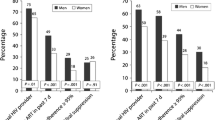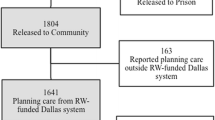Abstract
Over 9 million persons in the United States (US) are admitted each year to jails. HIV prevalence among detainees is higher than the general population, which creates a public health need for linking HIV-infected detainees to services during jail and after release. The EnhanceLink initiative was funded as demonstration projects in 10 communities at 20 separate jails across the US. Grantees implemented and evaluated innovative models of HIV testing in jails and linkage of HIV-infected individuals to community services post release. In this paper, we describe services delivered with the EnhanceLink initiative. During 877,119 admission events, 210,267 inmates agreed to HIV testing and 822 new diagnoses of HIV were made. The majority of persons served with transitional services were previously diagnosed before the current incarceration. Cumulatively, 9,837 HIV+ persons were offered linkage and transitional services and 8,056 (82 %) accepted the offer. EnhanceLink demonstrated the feasibility of HIV testing in jail settings and provision of linkage services to enhance continuity of HIV care post-release.


Similar content being viewed by others
References
Grinstead OA, Zack B, Faigeles B, Grossman N, Blea L. Reducing postrelease HIV risk among male prison inmates: a peer-led intervention. Crim Justice Behav. 1999;26(4):453–65.
Hammett TM, Gaiter JL, Crawford C. Reaching seriously at-risk populations: health interventions in criminal justice settings. Health Educ Behav. 1998;25(1):99–120.
Spaulding A, Stephenson B, Macalino G, Ruby W, Clarke JG, Flanigan TP. Human immunodeficiency virus in correctional facilities: a review. Clin Infect Dis. 2002;35(3):305–12.
Glaser JB, Greifinger RB. Correctional health care: a public health opportunity. Ann Intern Med. 1993;118(2):139–45.
Hammett TM. Making the case for health interventions in correctional facilities. J Urban Health. 2001;78(2):236–40.
Farley JL, Mitty JA, Lally MA, et al. Comprehensive medical care among HIV-positive incarcerated women: the Rhode Island experience. J Womens Health Gend-Based Med. 2000;9(1):51–6.
Flanigan TP, Rich JD, Spaulding A. HIV care among incarcerated persons: a missed opportunity [comment]. AIDS. 1999;13(17):2475–6.
Draine J, Ahuja D, Altice FL, et al. Strategies to enhance linkages between care for HIV/AIDS in jail and community settings. AIDS Care. 2011;23(3):366–77.
Flanigan TP, Zaller N, Beckwith CG, et al. Testing for HIV, sexually transmitted infections, and viral hepatitis in jails: still a missed opportunity for public health and HIV prevention. J Acquir Immune Defic Syndr. 2010;55(Suppl 2):S78–83.
Spaulding AC, Seals RM, Page MJ, Brzozowski AK, Rhodes W, Hammett TM. HIV/AIDS among inmates of and releasees from US correctional facilities, 2006: declining share of epidemic but persistent public health opportunity. PLoS ONE. 2009;4(11):e7558.
Westergaard RP, Kirk GD, Richesson DR, Galai N, Mehta SH. Incarceration predicts virologic failure for HIV-infected injection drug users receiving antiretroviral therapy. Clin Infect Dis. 2011;53(7):725–31.
Springer SA, Spaulding AC, Meyer JP, Altice FL. Public health implications for adequate transitional care for HIV-infected prisoners: five essential components. Clin Infect Dis. 2011;53(5):469–79.
Sperling C, Pierce A, Hall T, Tomlin J, Williams S. Intervening with substance using men newly released from jail challenges and strategies. In: National STD conference 2004.
Zaller ND, Holmes L, Dyl AC, et al. Linkage to treatment and supportive services among HIV-positive ex-offenders in Project Bridge. J Health Care Poor Underserved. 2008;19(2):522–31.
Rich JD, Holmes L, Salas C, et al. Successful linkage of medical care and community services for HIV-positive offenders being released from prison. J Urban Health. 2001;78(2):279–89.
Centers for Disease Control and Prevention. Framework for Program Evaluation in Public Health. MMWR 1999;48(No. RR-11).
HRSA, HIV/AIDS Bureau. Opening doors. The HRSA-CDC Corrections Demonstration Project for People Living with HIV/AIDS. December 2007. ftp://ftp.hrsa.gov/hab/opening_doors.pdf. Accessed 23 Feb 2008.
Robillard A, Garner J, Laufer F. CDC/HRSA HIV/AIDS intervention, prevention, and continuity of care demonstration project for incarcerated individuals within correctional settings and the community: part I, a description of correctional demonstration project activities. J Correct Health Care. 2003;9:453–86.
CDC. Assessment of sexually transmitted diseases services in city and county jails—United States, 1997. Morb Mortal Wkly Rep. 1998;47(21):429–31.
Spaulding AC, Perez SD, Seals RM, Kavasery R, Hallman M, Weiss P. The diversity of release patterns for jail detainees: implications for public health interventions. Am J Public Health. 2011;101:S347–52. doi:10.2105/AJPH.2010.300004.
de Voux A, Spaulding AC, Beckwith C, et al. Early identification of HIV: empirical support for jail-based screening. PLoS ONE. 2012;7(5):e37603.
Acknowledgments
Funded under HRSA Cooperative Agreement U90HA07632, Emory Center for AIDS Research Grant P30AI050409 and a Development and Dissemination Grant from Abt Associates Inc.
Author information
Authors and Affiliations
Corresponding author
Additional information
This study was conducted on behalf of EnhanceLink Study Group.
Electronic Supplementary Material
Below is the link to the electronic supplementary material.
Rights and permissions
About this article
Cite this article
Spaulding, A.C., Booker, C.A., Freeman, S.H. et al. Jails, HIV Testing, and Linkage to Care Services: An Overview of the EnhanceLink Initiative. AIDS Behav 17 (Suppl 2), 100–107 (2013). https://doi.org/10.1007/s10461-012-0339-2
Published:
Issue Date:
DOI: https://doi.org/10.1007/s10461-012-0339-2




